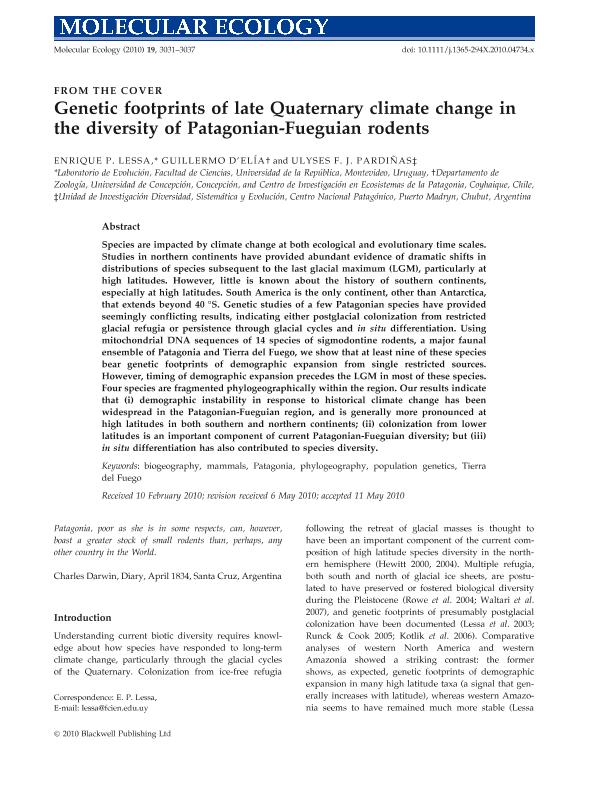Mostrar el registro sencillo del ítem
dc.contributor.author
Lessa, Enrique P.

dc.contributor.author
D'elía, Guillermo

dc.contributor.author
Pardiñas, Ulises Francisco J.

dc.date.available
2020-01-09T20:05:19Z
dc.date.issued
2010-07
dc.identifier.citation
Lessa, Enrique P.; D'elía, Guillermo; Pardiñas, Ulises Francisco J.; Genetic footprints of late Quaternary climate change in the diversity of Patagonian-Fueguian rodents; Wiley Blackwell Publishing, Inc; Molecular Ecology; 19; 15; 7-2010; 3031-3037
dc.identifier.issn
0962-1083
dc.identifier.uri
http://hdl.handle.net/11336/94203
dc.description.abstract
Species are impacted by climate change at both ecological and evolutionary time scales. Studies in northern continents have provided abundant evidence of dramatic shifts in distributions of species subsequent to the last glacial maximum (LGM), particularly at high latitudes. However, little is known about the history of southern continents, especially at high latitudes. South America is the only continent, other than Antarctica, that extends beyond 40 °S. Genetic studies of a few Patagonian species have provided seemingly conflicting results, indicating either postglacial colonization from restricted glacial refugia or persistence through glacial cycles and in situ differentiation. Using mitochondrial DNA sequences of 14 species of sigmodontine rodents, a major faunal ensemble of Patagonia and Tierra del Fuego, we show that at least nine of these species bear genetic footprints of demographic expansion from single restricted sources. However, timing of demographic expansion precedes the LGM in most of these species. Four species are fragmented phylogeographically within the region. Our results indicate that (i) demographic instability in response to historical climate change has been widespread in the Patagonian-Fueguian region, and is generally more pronounced at high latitudes in both southern and northern continents; (ii) colonization from lower latitudes is an important component of current Patagonian-Fueguian diversity; but (iii) in situ differentiation has also contributed to species diversity.
dc.format
application/pdf
dc.language.iso
eng
dc.publisher
Wiley Blackwell Publishing, Inc

dc.rights
info:eu-repo/semantics/openAccess
dc.rights.uri
https://creativecommons.org/licenses/by-nc-sa/2.5/ar/
dc.subject
BIOGEOGRAPHY
dc.subject
MAMMALS
dc.subject
PATAGONIA
dc.subject
PHYLOGEOGRAPHY
dc.subject
POPULATION GENETICS
dc.subject
TIERRA DEL FUEGO
dc.subject.classification
Zoología, Ornitología, Entomología, Etología

dc.subject.classification
Ciencias Biológicas

dc.subject.classification
CIENCIAS NATURALES Y EXACTAS

dc.title
Genetic footprints of late Quaternary climate change in the diversity of Patagonian-Fueguian rodents
dc.type
info:eu-repo/semantics/article
dc.type
info:ar-repo/semantics/artículo
dc.type
info:eu-repo/semantics/publishedVersion
dc.date.updated
2019-11-25T18:00:15Z
dc.journal.volume
19
dc.journal.number
15
dc.journal.pagination
3031-3037
dc.journal.pais
Reino Unido

dc.journal.ciudad
Londres
dc.description.fil
Fil: Lessa, Enrique P.. Universidad de la República; Uruguay
dc.description.fil
Fil: D'elía, Guillermo. Universidad de Concepción; Chile
dc.description.fil
Fil: Pardiñas, Ulises Francisco J.. Consejo Nacional de Investigaciones Científicas y Técnicas. Centro Nacional Patagónico; Argentina
dc.journal.title
Molecular Ecology

dc.relation.alternativeid
info:eu-repo/semantics/altIdentifier/doi/http://dx.doi.org/10.1111/j.1365-294X.2010.04734.x
dc.relation.alternativeid
info:eu-repo/semantics/altIdentifier/url/https://onlinelibrary.wiley.com/doi/abs/10.1111/j.1365-294X.2010.04734.x
Archivos asociados
